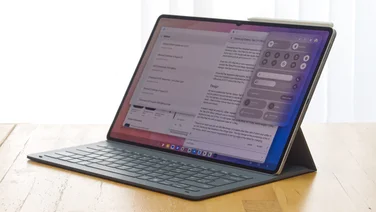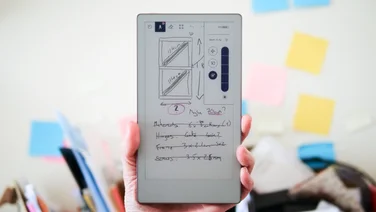To help us provide you with free impartial advice, we may earn a commission if you buy through links on our site. Learn more

- Case and pen included
- Case and pen included
- Case and pen included
- Case and pen included
- Well-thought-out software
- Well-thought-out software
- Well-thought-out software
- Well-thought-out software
- Superb handwriting-to-text conversion
- Superb handwriting-to-text conversion
- Superb handwriting-to-text conversion
- Superb handwriting-to-text conversion
- Still pricey
- Still pricey
- Still pricey
- Still pricey
- Iffy Google Drive implementation
- Iffy Google Drive implementation
- Iffy Google Drive implementation
- Iffy Google Drive implementation
- Not quite as nice as ReMarkable
- Not quite as nice as ReMarkable
- Not quite as nice as ReMarkable
- Not quite as nice as ReMarkable
The digital notebook, E Ink tablet market is still undoubtedly niche, but the sheer number of review units we’ve had in the last few months suggests it’s a growing one.
With its Smart Paper model, Lenovo joins dedicated note-taking companies ReMarkable and Onyx, ebook-reader makers Amazon and Kobo, and rival tablet manufacturer Huawei in designing a slate built for writing and sketches rather than YouTube and games.
Lenovo Smart Paper review: What do you get for the money?
The trouble is that most of these products have, thus far, proved rather expensive, and the Lenovo is no different. How much are we talking? The Lenovo Smart Paper and its stylus pen will set you back £400 when bought direct from Lenovo, a price the company claims is £50 off RRP.That’s clearly expensive, but it actually puts it pretty much bang in the middle of the mid range for this class of tablet. Our favourite, the ReMarkable 2, comes in at £398 once you throw in a Marker stylus, and even Amazon, with its unique ability to absorb costs, only manages to bring its Kindle Scribe down to £330.
If you want a colour display, the Android-powered Onyx Boox Tab Ultra C will set you back £600, while also-rans such as the Huawei MatePad Paper and Kobo Elipsa 2E come in at £420 and £350 respectively.

So it’s pricey, then, but still competitive. And while Lenovo isn’t the cheapest, the price does include a 4,096-pressure-sensitive stylus, a case, a charger and replacement stylus nibs in the box.
You also get the tablet itself: a surprisingly light (408g) 10.3in slate that’s just 5.5mm thick. It has a resolution of 1,872 x 1,404 and a pixel density of 227ppi (pixels per inch).

According to Lenovo, the Smart Paper runs on Android but, unlike E Ink tablets from Boox, you wouldn’t know it, as it’s heavily skinned with no access to the Google Play store. The deliberately limited functionality means the included 1.8GHz Rockchip RK3566 processor and 4GB RAM is sufficient to keep things running smoothly.
It has 64GB of eMMC storage for your doodles, notes and ebooks, and packs a 3,550mAh battery that Lenovo says is good for 8,500 pages of reading time, whatever that means. But as this is E Ink, you can expect a battery life that can be measured in weeks rather than hours.
Lenovo Smart Paper review: What do we like about it?
First of all, it’s a great-looking package and it’s superbly designed. The stylus magnetically sticks to a groove at the side of the screen, which lines up with a bulge in the cover to keep it firmly in place.
This sensible design continues to the software. Lenovo has clearly thought a lot about the limitations of E Ink and provided a tablet that only includes things offering at least a passable experience. One of my criticisms of the Boox Onyx Tab Ultra C was that, with unfiltered Android, much of the software simply wasn’t suitable.

That isn’t an issue here and it’s all the better for it. There’s only a small selection of apps – email, a calculator, a calendar, a clock, WPS Office, an Ebook reader, a file manager and Firefox – and nothing extra. No games and no video player, which is completely sensible given the bad experience they would inevitably offer. In fact, even the included Firefox web browser comes with a warning that some websites (YouTube, for instance) won’t perform very well.
It’s not perfect – trying to connect Gmail to the email app threw up an error because there was nowhere to input a two-factor-authentication code – but it’s a sensible way of playing to E Ink’s advantages without exposing its limitations.

The writing experience is also pretty solid, but I would give special credit to the handwriting-to-text conversion, which is incredibly good, even with lousy handwriting like mine. The recognition process does take a little while, but it’s certainly quicker than transcribing.
And unlike the ReMarkable 2, it has a backlight, with adjustable brightness and warmth. I’m not sure how often you’ll want to doodle in low-light conditions, and pen-and-paper sketchbooks have coped without lights for centuries, but it sure is a nice feature to have.
Lenovo Smart Paper review: What could it do better?
Compared with the ReMarkable 2, writing on the Lenovo Smart Paper doesn’t feel quite as smooth. There’s a secret sauce that ReMarkable has – something about the pen, the screen feel and the incredible responsiveness – that still leaves it unmatched in this space.
Text also appears a little grainy and jagged on the Smart Paper, probably due to the 226ppi screen, which is a bit below the Kindle Scribe’s 300ppi. Still, this is the same as ReMarkable 2 and it isn’t really a problem if you’re just looking to get notes down quickly. It may be more of an issue if you’re an artist looking to sketch, though.

And while Google Drive integration is welcome (this actually works with 2FA, unlike the email app), if you have a lot of files and folders, expect it to be slow and tricky to navigate. You have to download files from Drive to your device for editing, with Lenovo promising that you can “view everything in almost any file format, from epub to pdf and docx”. Unfortunately, that doesn’t include Google Docs’ file format, which are saved as .null files, rendering it all a bit pointless for me.
Still, you can at least quickly save your notepads there for reading elsewhere. It’s a shame only Google Drive is natively supported. Being able to link to other solutions like OneDrive or Dropbox would be welcome.
Finally, the dual microphone means you can make recordings alongside your written notes, which is great, although this doesn’t work as it does in the Notability app – you can’t tap words to jump to that position in the audio. The other issue is that the Smart Paper has no speakers, meaning you’ll need to hook up some Bluetooth headphones to actually play them back.
Lenovo Smart Paper: Should you buy it?
None of these things is especially bad but, with so little between the various E Ink tablets, it all comes down to small differences.
The Lenovo Smart Paper is an excellent device with well-thought-out software, and I’m sure you’d be very happy with it if you bought one. But does it do anything so brilliantly that it should be picked ahead of its rivals? I’m not so sure. For me, it doesn’t offer quite as nice a writing experience as the ReMarkable 2, even if the software is a bit more flexible. And if price is the main driver, you simply can’t beat Amazon’s Kindle Scribe — especially if you wait until Prime Day or Black Friday.
If you’re seeking an E Ink tablet that allows you to go beyond note-taking, into email, your calendar and web browsing, then this is a great jack of all trades and – within the crazy prices of the E Ink tablet world – pretty good value. Whether that’s enough for it to thrive in a small, expensive niche is another matter.







